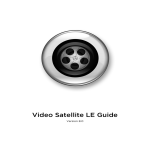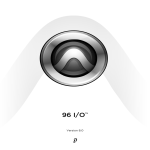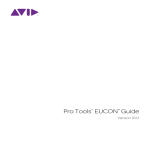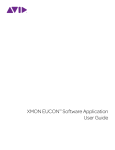Download DigiDesign Video Satellite LE Specifications
Transcript
Video Satellite LE Guide Version 10.0 Legal Notices This guide is copyrighted ©2011 by Avid Technology, Inc., (hereafter “Avid”), with all rights reserved. Under copyright laws, this guide may not be duplicated in whole or in part without the written consent of Avid. 003, 96 I/O, 96i I/O, 192 Digital I/O, 192 I/O, 888|24 I/O, 882|20 I/O, 1622 I/O, 24-Bit ADAT Bridge I/O, AudioSuite, Avid, Avid DNA, Avid Mojo, Avid Unity, Avid Unity ISIS, Avid Xpress, AVoption, Axiom, Beat Detective, Bomb Factory, Bruno, C|24, Command|8, Control|24, DCommand, D-Control, D-Fi, D-fx, D-Show, D-Verb, DAE, Digi 002, DigiBase, DigiDelivery, Digidesign, Digidesign Audio Engine, Digidesign Intelligent Noise Reduction, Digidesign TDM Bus, DigiDrive, DigiRack, DigiTest, DigiTranslator, DINR, DV Toolkit, EditPack, Eleven, EUCON, HD Core, HD Process, Hybrid, Impact, Interplay, LoFi, M-Audio, MachineControl, Maxim, Mbox, MediaComposer, MIDI I/O, MIX, MultiShell, Nitris, OMF, OMF Interchange, PRE, ProControl, Pro Tools M-Powered, Pro Tools, Pro Tools|HD, Pro Tools LE, QuickPunch, RectiFi, Reel Tape, Reso, Reverb One, ReVibe, RTAS, Sibelius, Smack!, SoundReplacer, Sound Designer II, Strike, Structure, SYNC HD, SYNC I/O, Synchronic, TL Aggro, TL AutoPan, TL Drum Rehab, TL Everyphase, TL Fauxlder, TL In Tune, TL MasterMeter, TL Metro, TL Space, TL Utilities, Transfuser, Trillium Lane Labs, Vari-Fi, Velvet, X-Form, and XMON are trademarks or registered trademarks of Avid Technology, Inc. Xpand! is Registered in the U.S. Patent and Trademark Office. All other trademarks are the property of their respective owners. Product features, specifications, system requirements, and availability are subject to change without notice. Guide Part Number 9329-65122-00 REV A 10/11 Documentation Feedback At Avid, we are always looking for ways to improve our documentation. If you have comments, corrections, or suggestions regarding our documentation, email us at [email protected]. Contents Chapter 1. Introduction to Video Satellite LE . . . . . . . . . . . . . . . . . . . . . . . . . . . . . . . . . . . . . . . 1 Video Output Options . . . . . . . . . . . . . . . . . . . . . . . . . . . . . . . . . . . . . . . . . . . . . . . . . . . . . . 1 Supported Video Formats. . . . . . . . . . . . . . . . . . . . . . . . . . . . . . . . . . . . . . . . . . . . . . . . . . . 1 System Requirements and Compatibility . . . . . . . . . . . . . . . . . . . . . . . . . . . . . . . . . . . . . . . . 2 Registration . . . . . . . . . . . . . . . . . . . . . . . . . . . . . . . . . . . . . . . . . . . . . . . . . . . . . . . . . . . . . 2 About This Guide . . . . . . . . . . . . . . . . . . . . . . . . . . . . . . . . . . . . . . . . . . . . . . . . . . . . . . . . . 2 Conventions Used in This Guide . . . . . . . . . . . . . . . . . . . . . . . . . . . . . . . . . . . . . . . . . . . . . . 3 About www.avid.com . . . . . . . . . . . . . . . . . . . . . . . . . . . . . . . . . . . . . . . . . . . . . . . . . . . . . . 3 Chapter 2. Installing Video Satellite LE . . . . . . . . . . . . . . . . . . . . . . . . . . . . . . . . . . . . . . . . . . . . 5 Authorizing Video Satellite LE . . . . . . . . . . . . . . . . . . . . . . . . . . . . . . . . . . . . . . . . . . . . . . . . 5 Network Connections . . . . . . . . . . . . . . . . . . . . . . . . . . . . . . . . . . . . . . . . . . . . . . . . . . . . . . 6 Chapter 3. Configuring Video Satellite LE . . . . . . . . . . . . . . . . . . . . . . . . . . . . . . . . . . . . . . . . . . 7 Configuring Network Settings . . . . . . . . . . . . . . . . . . . . . . . . . . . . . . . . . . . . . . . . . . . . . . . . 7 Connecting a Video Satellite LE System to another Pro Tools System . . . . . . . . . . . . . . . . . . 8 Chapter 4. Using Video Satellite LE . . . . . . . . . . . . . . . . . . . . . . . . . . . . . . . . . . . . . . . . . . . . . . 11 Getting Started . . . . . . . . . . . . . . . . . . . . . . . . . . . . . . . . . . . . . . . . . . . . . . . . . . . . . . . . . 11 Linking the Video Satellite LE System . . . . . . . . . . . . . . . . . . . . . . . . . . . . . . . . . . . . . . . . . 11 Spotting Video to the Pro Tools Timeline . . . . . . . . . . . . . . . . . . . . . . . . . . . . . . . . . . . . . . . 13 Optimizing Synchronization Settings Between the Administrator and Satellite Systems . . . . . 13 Contents 3 4 Video Satellite LE Guide Chapter 1: Introduction to Video Satellite LE Video Satellite LE is a powerful post-production option for Pro Tools ®, which uses a separate Mac OS X computer running Pro Tools software for synchronized video playback. By off-loading video playback duties to a separate computer, Video Satellite LE contributes to the best possible performance on the administrator Pro Tools system. The Satellite Link option provides more advanced multi-system linking features between multiple Pro Tools systems. For more information on Satellite Link, see the Satellite Link Guide . Supported Video Formats Video Satellite LE supports the import and playback of all standard SD and HD Quicktime video formats, including 720p and 1080p resolutions at all standard frame rates. Video for use with Video Satellite LE can be encoded with any common QuickTime codec, including HD codecs such as h.264, DVCPro 100, and HDV. For more information on supported formats, see the documentation included with your supported PCIe video card. Video Output Options Video Satellite LE lets you output video through a supported PCIe video card in a variety of connection formats: • Playback to an external NTSC or PAL analog video monitor • Playback to an external SDI video monitor (10-bit SD or HD, or 2k) • Playback to an external HDMI video monitor • Playback to an external analog HD video monitor Chapter 1: Introduction to Video Satellite LE 1 System Requirements and Compatibility Avid ® can only assure compatibility and provide support for hardware and software it has tested and approved. For complete system requirements and a list of Avid-qualified computers, operating systems, hard drives, and third-party devices, visit: www.avid.com/compatibility Administrator System Requirements • Avid-qualified Mac OS X or Windows 7 computer running Pro Tools HD software • Avid Pro Tools|HD or HD Native hardware • Avid SYNC HD™ or SYNC I/O™ peripheral • Ethernet connection to a Local Area Network (LAN) Video Satellite LE System Requirements • Avid-qualified Mac OS X computer • Avid Pro Tools or Pro Tools HD software • Supported PCIe video card or Avid Mojo SDI video peripheral (optional) • Client monitor (optional) • Black burst or tri-level video reference generator, if using a PCIe video card or Mojo SDI • Ethernet connection to a Local Area Network (LAN) • iLok USB Smart Key with authorization for the Video Satellite LE option 2 Video Satellite LE Guide Registration Your software purchase is automatically registered when you activate your iLok license (see “Authorizing Video Satellite LE” on page 5). Registered users are eligible to receive software update and upgrade notices. For information on technical support, visit www.avid.com. About This Guide This guide describes features of the Video Satellite LE option. For complete instructions on connecting and configuring your Pro Tools system, see the guide that came with your system. For additional information about using Pro Tools software, see the Pro Tools Reference Guide. Conventions Used in This Guide All of our guides use the following conventions to indicate menu choices and key commands: : Convention Action File > Save Choose Save from the File menu Control+N Hold down the Control key and press the N key Control-click Hold down the Control key and click the mouse button Right-click Click with the right mouse button The names of Commands, Options, and Settings that appear on-screen are in a different font. The following symbols are used to highlight important information: User Tips are helpful hints for getting the most from your system. Important Notices include information that could affect your data or the performance of your system. About www.avid.com The Avid website (www.avid.com) is your best online source for information to help you get the most out of your Pro Tools system. The following are just a few of the services and features available. Product Registration Register your purchase online. Support and Downloads Contact Avid Customer Success (technical support); download software updates and the latest online manuals; browse the Compatibility documents for system requirements; search the online Knowledge Base or join the worldwide Pro Tools community on the User Conference. Training and Education Study on your own using courses available online or find out how you can learn in a classroom setting at a certified Pro Tools training center. Products and Developers Learn about Avid products; download demo software or learn about our Development Partners and their plug-ins, applications, and hardware. News and Events Get the latest news from Avid or sign up for a Pro Tools demo. Shortcuts show you useful keyboard or mouse shortcuts. Cross References point to related sections in this guide and other Avid guides. Chapter 1: Introduction to Video Satellite LE 3 4 Video Satellite LE Guide Chapter 2: Installing Video Satellite LE Authorizing Video Satellite LE Video Satellite LE is automatically installed with Pro Tools, but requires a valid Video Satellite LE authorization in order to be enabled in Pro Tools. The Video Satellite LE feature set for Pro Tools is automatically enabled if a valid Video Satellite LE authorization is detected on your iLok. The iLok USB Smart Key (iLok) is manufactured by PACE Anti-Piracy and is included with certain Pro Tools systems or can be purchased separately. Software is authorized using the iLok USB Smart Key (iLok), manufactured by PACE Anti-Piracy. Authorizing Downloaded Software If you downloaded software from the Avid Store (http://shop.avid.com), you authorize it by downloading a license from iLok.com to an iLok. For more information, visit the iLok website (www.iLok.com). Authorizing Boxed Versions of Software If you purchased a boxed version of software, it comes with an Activation Code (on the included Activation Card). To authorize software using an Activation Code: If you do not have an iLok.com account, visit www.iLok.com and sign up for an account. 1 iLok USB Smart Key Transfer the license for your software to your iLok.com account by doing the following: 2 You can use either the new version of the iLok (shown above) or the previous version of the iLok to hold your authorizations. An iLok can hold over 100 licenses for all of your iLok-enabled software. Once a license for a given piece of software is placed on an iLok, you can use the iLok to authorize that software on any computer. • Visit www.avid.com/activation. – and – • Input your Activation Code (listed on your Activation Card) and your iLok.com User ID. Your iLok.com User ID is the name you create for your iLok.com account. An iLok USB Smart Key is not supplied with plug-ins or software options. You can use the iLok included with certain Pro Tools systems or purchase one separately. Chapter 2: Installing Video Satellite LE 5 Transfer the licenses from your iLok.com account to your iLok USB Smart Key by doing the following: 3 • Insert the iLok into an available USB port on your computer. • Go to www.iLok.com and log in. • Follow the on-screen instructions for transferring your licences to your iLok. For more information, visit the iLok website (www.iLok.com). 4 Launch Pro Tools. If you have any installed unauthorized plug-ins or software options, you will be prompted to authorize them. Follow the on-screen instructions to complete the authorization process. 5 Network Connections The Video Satellite LE system and the administrator Pro Tools system it works with must be connected to an Ethernet LAN (Local Area Network). It is recommended that the systems be on the same Ethernet switch, in order to minimize response time over the network. In order for audio and video playback to be frame edge aligned, it is recommended that a SYNC peripheral be connected to the administrator Pro Tools system, and that the SYNC be locked to black burst or tri-level sync. For trilevel sync, a SYNC|HD is required. SYNC peripherals are only for use with Pro Tools systems with Pro Tools HD hardware. If using a qualified PCIe video card or Avid video peripheral on the Video Satellite LE system, the video hardware should also be locked to the same video reference signal that the SYNC peripheral is referencing. 6 Video Satellite LE Guide Chapter 3: Configuring Video Satellite LE Configuring Network Settings The Video Satellite LE system communicates with the administrator Pro Tools system over an Ethernet LAN. Ethernet Interface On computers with multiple Ethernet interfaces, you can select the interface you want to use to connect the two systems. To select the Ethernet interface for Video Satellite LE: 1 On the administrator Pro Tools system, choose Setup > Peripherals and click Satellites. Under Advanced Network Settings, select the Ethernet interface from the Interface pop-up menu. 2 3 TCP/UDP Port The two systems need to use the same TCP/UDP port to communicate. The TCP/UDP port defaults to 28282. If the default port is already in use, or if you want to set up separate Video Satellite LE, Video Satellite, or Satellite Link networks, you can select a different TCP/UDP port for communication. To select the TCP/UDP port for Video Satellite LE communication: 1 Under Advanced Network Settings, enter the TCP/UDP port number you want the system to use. 2 For Video Satellite LE to function properly, you must select a TCP/UDP port number between 1024 and 65534. Click OK. Repeat the above steps for the satellite Pro Tools system. On the administrator Pro Tools system, choose Setup > Peripherals and click Satellites. 4 3 Click OK. Repeat the above steps for the satellite Pro Tools system. 4 Chapter 3: Configuring Video Satellite LE 7 Connecting a Video Satellite LE System to another Pro Tools System To connect the Video Satellite LE system to the administrator Pro Tools system, that system must be designated an administrator system. The Video Satellite LE system is set up as a satellite system, and then is declared from the administrator system. Configuring the Video Satellite LE System To set up the Video Satellite LE system: On the satellite Pro Tools system, choose Setup > Peripherals and click Satellites. 1 In the System Name text box, enter a name for the system. 2 3 Under Mode, choose Enable Satellite Mode. 4 Click OK. Configuring the main Pro Tools System as an Administrator To configure the main Pro Tools system as an administrator: 1 On the Pro Tools system, choose Setup > Pe- ripherals and click Satellites. In the System Name text box, enter a name for the system. 2 3 Under Mode, choose Administrator. Under Administrator, choose the current system from the one of the system pop-up menus. 4 5 Click OK. Configuring an Administrator system in the Satellites page of the Peripherals dialog 8 Video Satellite LE Guide Configuring a Video Satellite LE system in the Satellites page of the Peripherals dialog Declaring The Video Satellite LE System When the Video Satellite LE system has been been configured as a satellite, it becomes available on the administrator system. The satellite system is then declared to connect it to the main Pro Tools. To declare the satellite system on the administrator system: 1 On the Pro Tools administrator system, choose Setup > Peripherals and click Satellites. 2 Under Administrator, declare the system you want to use as a satellite from the System 2–5 pop-up menus. 3 Click OK. The systems appear, in order, from left to right, in the Synchronization section of the Transport window. Only one Video Satellite LE system can be connected to a main Pro Tools system at a time. Chapter 3: Configuring Video Satellite LE 9 10 Video Satellite LE Guide Chapter 4: Using Video Satellite LE Getting Started Link Button Controls the link status of the local Before the Video Satellite LE system can be used to play back video, the video file(s) must be imported to a video track in a Pro Tools session. Satellite Link Buttons control the link status of For information on creating and opening sessions and importing video files in Pro Tools, see the Pro Tools Reference Guide. system. the other satellite systems. On every system, one of these buttons corresponds to that system’s main Link button. Link buttons highlight to indicate linked status. To display link controls in the Transport window: Choose View > Transport > Synchronization and View > Transport > Expanded. Linking the Video Satellite LE System After a Pro Tools system has been connected as a video satellite, it can then be placed in a linked state. When this system is linked, it follows the transport commands from the administrator system, and runs in sync with it. When the satellite system is unlinked, its transport acts like a normal Pro Tools system. Link button Satellite link buttons Link controls in the Transport window The administrator Pro Tools system does not respond to playback commands from the Video Satellite LE system. Transport commands must originate from the main Pro Tools system. Link Controls When a Pro Tools system has been declared as a satellite, the following controls appear in the Transport window: To link or unlink the local Video Satellite LE system: Click the Link button in the Transport window. To link or unlink the administrator Pro Tools system or other satellite systems: Click the corresponding Satellite Link button in the Transport window. Chapter 4: Using Video Satellite LE 11 To link or unlink all declared satellite systems: Option-click (Mac) or Alt-click (Windows) the Link button or one of the Satellite Link buttons in the Transport window. To clear an error dialog on the Video Satellite LE system from the main Pro Tools system: In the Transport window on the other linked system, Shift-click the Satellite Link button for the affected system. Linking Systems During Playback If the administrator system is configured to Transmit Play Selections, those selections will be transmitted to the Video Satellite LE system. However, selections made on the Video Satellite LE system will not be transmitted to the administrator system. You can link the Video Satellite LE system while the administrator Pro Tools system is playing back, and the transports will synchronize. Video Satellite LE Operation DAE Errors By default, the two linked systems will continue to operate if one of the systems experiences an error and its transport stops. The administrator system can be configured to stop playback if a DAE error occurs on the Video Satellite LE system, or any other Satellite Link satellite. To set the Video Satellite system to stop the transport on both systems when an error occurs: On the administrator Pro Tools system, make sure the DAE Errors Stop All Linked Systems option is selected in the Synchronization Preferences page. If one of the systems encounters a DAE error, its satellite link button will light up red in the transport window on the other system. Hold the mouse pointer over the button to view the error, if necessary. Modal Dialogs Linked systems will stop playback if a modal dialog box (such as the I/O Setup, Hardware Setup, or Playback Engine dialog) is opened on any linked system. . A system cannot play back when a modal dialog box is open. 12 Video Satellite LE Guide Spotting Video to the Pro Tools Timeline Once a session is created (or an existing session opened) on the satellite Pro Tools system, and the video has been imported, the video must be set to the correct start time so that it runs in sync with the audio on the main Pro Tools system. To compensate for different start times: In Pro Tools, go to Setup > Session. The Session Setup window appears. 1 In the Timecode Offsets section, compensate for the offset between Pro Tools and Video Satellite LE as follows: 2 • If the start time of the video clip in video satellite falls before the start time of the administrator Pro Tools session, type a positive timecode value into the Satellite Offset field. Video can be spotted to the desired start time by matching timecode or feet+frames values. For more information on spotting video in Pro Tools, see the Pro Tools Reference Guide. Optimizing Synchronization Settings Between the Administrator and Satellite Systems Compensating for Different Start Times in Pro Tools and Video Satellite LE In some cases, you may want the Video Satellite LE system to be offset from the administrator system to accommodate for external deck offsets or differences in session start time. You can control the amount of offset by changing the Timecode Offset parameters on the Pro Tools LE video satellite system. • If the start time of the video clip in video satellite falls after the start time of the administrator Pro Tools session, type a negative timecode value into the Satellite Offset field. Compensating for Monitor-Induced Output Delay Many monitors add a delay to the video output of one or more frames. You can compensate for this delay by advancing the video output by the necessary number of frames. To set the number of frames to offset video output: 1 On the video satellite system, choose Setup > Video Sync Offset. 2 In the Video Sync Offset field that matches the type of video you’re playing (QuickTime or Avid), type a positive value that matches the amount of delay in the monitors. You may need to try a few different settings. Chapter 4: Using Video Satellite LE 13 Avid Technical Support (USA) Product Information 2001 Junipero Serra Boulevard Daly City, CA 94014-3886 USA Visit the Online Support Center at www.avid.com/support For company and product information, visit us on the web at www.avid.com



























![Stage 48 - akmedia.[bleep]digidesign.](http://vs1.manualzilla.com/store/data/007247961_1-0fc36f720a3108317a47260e3de3799a-150x150.png)




